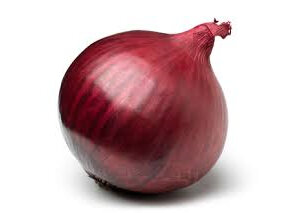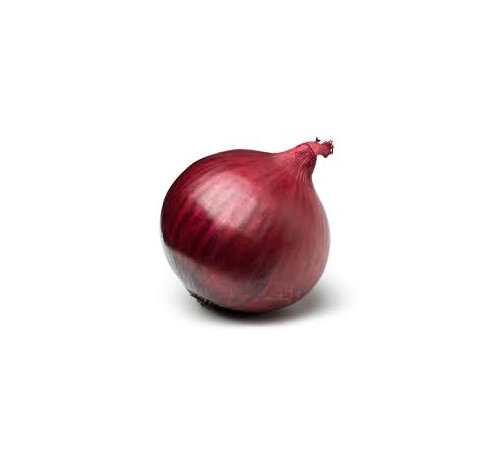IMPORTANT! If ordering for delivery outside of Timaru, please add Frozen Chiller Pack(s) to your order HERE
NEW SEASON - Beautiful sweet red onions for all your raw salads, slaws, pickles & caramelised red onion & balsamic marmalata goes well with your bbq's & summer entertaining. Also great for making raw cracker recipes & beautiful in a guacamole dip or salsa with the organic avocadoes. No GMO, no pesticides or herbicides here!
USA CERT ORGANIC - NOT FUMIGATED
What's New and Beneficial About Onions
- The flavonoids in onion tend to be more concentrated in the outer layers of the flesh. Peel off as little of the fleshy, edible portion as possible when removing the onion's outermost paper layer.
To bring out the sweet flavor of onions we recommend using our Healthy Saute method of cooking onions for just 7 minutes. Cut onions into slices of equal 1/4-inch thickness to help them cook more evenly. The thinner you slice the onions the more quickly they will cook. Let them sit for at least 5 minutes.
Health Benefits - There is much online :)
What would a kitchen be without the distinctively pungent smell and taste of onions filling out the flavors of almost every type of cuisine imaginable? Fortunately, yellow storage onions are available throughout the year although sweet varieties have a much more limited growing season and are available only a few months out of the year.
While onions may bring a tear to your eye and a pungency to your breath they will also certainly bring delight to your taste buds. The onion, known scientifically as Allium cepa, is, on the surface, a humble brown, white or red, paper-thin skinned bulb; yet, despite its plain looks, it has an intense flavor and is a beloved part of the cuisine of almost every region of the world.
The word onion comes from the Latin word unio, which means "single," or "one"—reflecting of the onion plant producing a single bulb, unlike its cousin, the garlic, that produces many small bulbs. The name also describes the onion bulb when cut down the middle; it is a union (also from unio) of many separate, concentrically arranged layers.
Onions range in size, color, and taste depending upon their variety. There are generally two types of large, globe-shaped onions, classified as spring/summer or storage onions. The former class includes those that are grown in warm weather climates and have characteristic mild or sweet tastes. Included in this group are the Maui Sweet Onion (in season April through June), Vidalia (in season May through June) and Walla Walla (in season July and August). Storage onions are grown in colder weather climates and, after harvesting, are dried out for a period of several months, which allows them to attain dry, crisp skins. They generally have a more pungent flavor and are usually named by their color: white, yellow or red. Spanish onions fall into this classification. In addition to these large onions, there are also smaller varieties such as the green onion, or scallion, and the pearl onion.
How to Select and Store
Choose onions that are clean, well shaped, have no opening at the neck, and feature crisp, dry outer skins. Avoid those that are sprouting or have signs of mold. In addition, onions of inferior quality often have soft spots, moisture at their neck, and dark patches, which may all be indications of decay. As conventionally grown onions are often irradiated to prevent them from sprouting, purchase organically grown varieties whenever possible to avoid onions that have undergone this process. When purchasing scallions, look for those that have green, fresh-looking tops that appear crisp yet tender. The base should be whitish in color for two or three inches. Avoid those that have wilted or yellowed tops.
Onions should be stored in a well ventilated space at room temperature, away from heat and bright light. With the exception of green onions, do not refrigerate onions. Place them in a wire hanging basket or a perforated bowl with a raised base so that air can circulate underneath. The length of storage varies with the type of onion. Those that are more pungent in flavor, such as yellow onions, should keep for about a month if stored properly. They will keep longer than those with a sweeter taste, such as white onions, since the compounds that confer their sharp taste help to preserve them. Scallions should be stored in a plastic bag in the refrigerator where they will keep for about one week. All onions should be stored away from potatoes, as they will absorb their moisture.
Store cut onions by placing in a sealed container; use them within a day or two since they tend to oxidize and lose their nutrient content rather quickly. Cooked onions will best maintain their taste in an airtight container where they can be kept for a few days; they should never be placed in a metal storage container as this may cause them to discolor. Although peeled and chopped onions can be frozen (without first being blanched), this process will cause them to lose some of their flavor.
Tips for Preparing and Cooking
Tips for Preparing Onions
Cut onions into 1/4-inch slices to cook them evenly and quickly. Let them sit for at least 5 minutes to help enhance their health-promoting benefits.
If cutting onions irritates your eyes, there are a few tricks that you can employ. Use a very sharp knife and always cut the onions while standing; that way your eyes will be as far away as possible. Consider cutting onions by an open window. If cutting onions really makes you cry, consider wearing glasses or goggles. Chill the onions for an hour or so before cutting; Cutting onions under cold, running water is a method that is often used to cut back on eye irritation.
How to Enjoy
A Few Quick Serving Ideas
- Combine chopped onions, tomatoes, avocado, and jalapeno for an all-in-one guacamole salsa dip.
- To perk up plain rice, top with green onions (scallions) and sesame seeds.
- Healthy Sauteed chopped onions can enhance the flavor or almost any vegetable dish.
- Enjoy a classic Italian salad—sliced onions, tomatoes, and mozzarella cheese drizzled with olive oil.







